集合
框架关系图
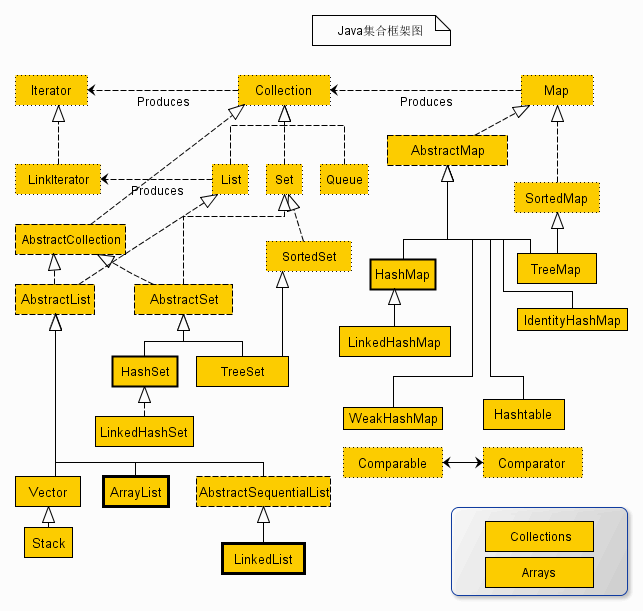
补充:HashTable父类是Dictionary,不是AbstractMap。
一:HashMap中的链循环:
一般来说HashMap中的链循环会发生在多线程操作时(虽然HashMap就不是线程安全的,一般多线程的时候也不会用它,但这种情况难免会发生)
以JDK1.7为例:
void addEntry(int hash, K key, V value, int bucketIndex) { if ((size >= threshold) && (null != table[bucketIndex])) { resize(2 * table.length);//扩容方法,参数为原来数组长度的2倍 hash = (null != key) ? hash(key) : 0; bucketIndex = indexFor(hash, table.length); } createEntry(hash, key, value, bucketIndex); } void resize(int newCapacity) { Entry[] oldTable = table;//数组原来的数据 int oldCapacity = oldTable.length;//原来数组的长度 if (oldCapacity == MAXIMUM_CAPACITY) { threshold = Integer.MAX_VALUE; return; } Entry[] newTable = new Entry[newCapacity];//以新的初始容量创建新的数组 transfer(newTable, initHashSeedAsNeeded(newCapacity));//转换方法 table = newTable; threshold = (int)Math.min(newCapacity * loadFactor, MAXIMUM_CAPACITY + 1); } void transfer(Entry[] newTable, boolean rehash) { int newCapacity = newTable.length; for (Entry<K,V> e : table) { while(null != e) { Entry<K,V> next = e.next; if (rehash) { e.hash = null == e.key ? 0 : hash(e.key); } int i = indexFor(e.hash, newCapacity);//e是oldTable上的Entry对象,这里算出新数组的下标 e.next = newTable[i]; newTable[i] = e; e = next; } } }
通过代码分析:当old Table中的数值都转移到newTable时,元素的顺序会进行颠倒。效果图如下:
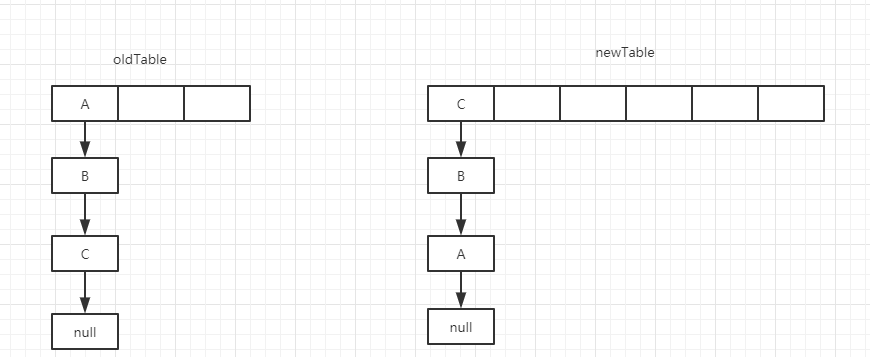
在这种情况下,假设有两个线程同时进行扩容的操作且都进入了transfer方法时,但是因为某个情况让线程一先执行完,线程二才开始执行。
这个时候如果线程一执行完了,线程二开始的状态就是这样:
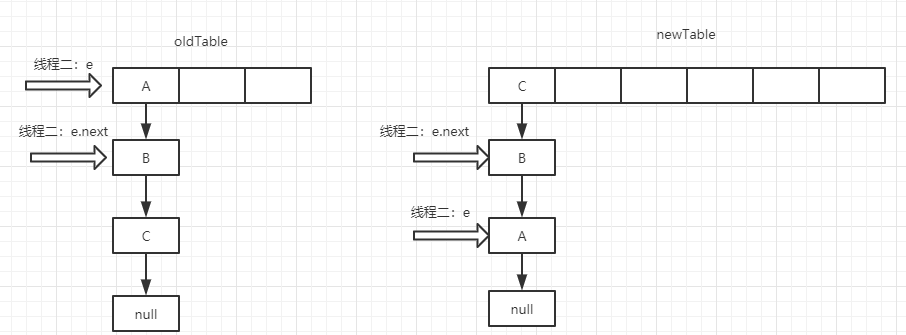
这个时候:线程二的e还是A对象,e.Next(A.Next)还是指向B,但是因为线程一的关系,实际上此时B.Next已经指向了A。于是就产生了循环:A.Next指向B,B.Next指向A。
二:hashtable
HashTable是Map接口下的一个子类,线程安全的,1.7和1.8差别不大,常和HashMap作比较,部分源码如下:

1 //hashTable默认初始容量和加载因子 2 public Hashtable() { 3 this(11, 0.75f); 4 } 5 6 //Put方法 7 public synchronized V put(K key, V value) { 8 // 不允许存null 9 if (value == null) { 10 throw new NullPointerException(); 11 } 12 13 // key相同时新值代替老值,并把老值返回出去 14 Entry tab[] = table; 15 int hash = hash(key);//哈希算法 16 int index = (hash & 0x7FFFFFFF) % tab.length; 17 for (Entry<K,V> e = tab[index] ; e != null ; e = e.next) { 18 if ((e.hash == hash) && e.key.equals(key)) { 19 V old = e.value; 20 e.value = value; 21 return old; 22 } 23 } 24 25 modCount++; 26 if (count >= threshold) { 27 rehash();//扩容 28 29 tab = table; 30 hash = hash(key); 31 index = (hash & 0x7FFFFFFF) % tab.length; 32 } 33 34 Entry<K,V> e = tab[index]; 35 tab[index] = new Entry<>(hash, key, value, e); 36 count++; 37 return null; 38 } 39 //哈希算法 40 private int hash(Object k) { 41 return hashSeed ^ k.hashCode(); 42 } 43 //扩容方法 44 protected void rehash() { 45 int oldCapacity = table.length; 46 Entry<K,V>[] oldMap = table; 47 48 int newCapacity = (oldCapacity << 1) + 1;//扩容后容量为原来的2倍再加1 49 if (newCapacity - MAX_ARRAY_SIZE > 0) { 50 if (oldCapacity == MAX_ARRAY_SIZE) 51 // Keep running with MAX_ARRAY_SIZE buckets 52 return; 53 newCapacity = MAX_ARRAY_SIZE; 54 } 55 Entry<K,V>[] newMap = new Entry[newCapacity]; 56 57 modCount++; 58 threshold = (int)Math.min(newCapacity * loadFactor, MAX_ARRAY_SIZE + 1); 59 boolean rehash = initHashSeedAsNeeded(newCapacity); 60 61 table = newMap; 62 63 for (int i = oldCapacity ; i-- > 0 ;) { 64 for (Entry<K,V> old = oldMap[i] ; old != null ; ) { 65 Entry<K,V> e = old; 66 old = old.next; 67 68 if (rehash) { 69 e.hash = hash(e.key); 70 } 71 int index = (e.hash & 0x7FFFFFFF) % newCapacity; 72 e.next = newMap[index]; 73 newMap[index] = e; 74 } 75 } 76 } 77 //remove方法 78 public synchronized V remove(Object key) { 79 Entry tab[] = table; 80 int hash = hash(key); 81 int index = (hash & 0x7FFFFFFF) % tab.length; 82 for (Entry<K,V> e = tab[index], prev = null ; e != null ; prev = e, e = e.next) { 83 if ((e.hash == hash) && e.key.equals(key)) { 84 modCount++; 85 if (prev != null) { 86 prev.next = e.next; 87 } else { 88 tab[index] = e.next; 89 } 90 count--; 91 V oldValue = e.value; 92 e.value = null; 93 return oldValue; 94 } 95 } 96 return null; 97 } 98 //get方法 99 public synchronized V get(Object key) { 100 Entry tab[] = table; 101 int hash = hash(key); 102 int index = (hash & 0x7FFFFFFF) % tab.length; 103 for (Entry<K,V> e = tab[index] ; e != null ; e = e.next) { 104 if ((e.hash == hash) && e.key.equals(key)) { 105 return e.value; 106 } 107 } 108 return null; 109 } 110 //keySet方法 111 public Set<K> keySet() { 112 if (keySet == null) 113 keySet = Collections.synchronizedSet(new KeySet(), this); 114 return keySet; 115 } 116 117 private class KeySet extends AbstractSet<K> { 118 public Iterator<K> iterator() { 119 return getIterator(KEYS); 120 } 121 public int size() { 122 return count; 123 } 124 public boolean contains(Object o) { 125 return containsKey(o); 126 } 127 public boolean remove(Object o) { 128 return Hashtable.this.remove(o) != null; 129 } 130 public void clear() { 131 Hashtable.this.clear(); 132 } 133 } 134 //entrySet方法 135 public Set<Map.Entry<K,V>> entrySet() { 136 if (entrySet==null) 137 entrySet = Collections.synchronizedSet(new EntrySet(), this); 138 return entrySet; 139 } 140 141 private class EntrySet extends AbstractSet<Map.Entry<K,V>> { 142 public Iterator<Map.Entry<K,V>> iterator() { 143 return getIterator(ENTRIES); 144 } 145 146 public boolean add(Map.Entry<K,V> o) { 147 return super.add(o); 148 } 149 150 public boolean contains(Object o) { 151 if (!(o instanceof Map.Entry)) 152 return false; 153 Map.Entry entry = (Map.Entry)o; 154 Object key = entry.getKey(); 155 Entry[] tab = table; 156 int hash = hash(key); 157 int index = (hash & 0x7FFFFFFF) % tab.length; 158 159 for (Entry e = tab[index]; e != null; e = e.next) 160 if (e.hash==hash && e.equals(entry)) 161 return true; 162 return false; 163 } 164 //clear方法 165 public synchronized void clear() { 166 Entry tab[] = table; 167 modCount++; 168 for (int index = tab.length; --index >= 0; ) 169 tab[index] = null; 170 count = 0; 171 } 172 //size方法和isEmpty方法 173 public synchronized int size() { 174 return count; 175 } 176 177 public synchronized boolean isEmpty() { 178 return count == 0; 179 }
可以看出和HashMap比较,有以下特点:
1、初始容量为11。
2、扩容方法为:oldTable.Length*2+1。
3、不允许存null值。
4、计算hash,和获取数组下标不同:
HashTable:
int hash = key.hashCode();
int index = (hash & 0x7FFFFFFF) % tab.length;
HashMap:
int hash = hash(key);//
int i = indexFor(hash, table.length);
5、HashTable线程安全,主要的方法都用了synchronized,加锁。
6、HashMap和HashTable父类不同
public class HashMap<K,V> extends AbstractMap<K,V> implements Map<K,V>, Cloneable, Serializable
public class Hashtable<K,V> extends Dictionary<K,V> implements Map<K,V>, Cloneable, java.io.Serializable
7、HashTable线程安全,但因为每个主要方法上都加上了锁,所以在执行效率上会慢很多。
三:其他线程安全Map
1、synchronizedMap
通过工具类Collections的方法,返回一个HashMap,例如:Map<String,String> map = Collections.synchronizedMap(new HashMap<String,String>());

1 public static <K,V> Map<K,V> synchronizedMap(Map<K,V> m) { 2 return new SynchronizedMap<>(m); 3 } 4 5 private static class SynchronizedMap<K,V> 6 implements Map<K,V>, Serializable { 7 private static final long serialVersionUID = 1978198479659022715L; 8 9 private final Map<K,V> m; // Backing Map 10 final Object mutex; // Object on which to synchronize 11 12 SynchronizedMap(Map<K,V> m) { 13 if (m==null) 14 throw new NullPointerException(); 15 this.m = m; 16 mutex = this; 17 } 18 19 SynchronizedMap(Map<K,V> m, Object mutex) { 20 this.m = m; 21 this.mutex = mutex; 22 } 23 24 public int size() { 25 synchronized (mutex) {return m.size();} 26 } 27 public boolean isEmpty() { 28 synchronized (mutex) {return m.isEmpty();} 29 } 30 public boolean containsKey(Object key) { 31 synchronized (mutex) {return m.containsKey(key);} 32 } 33 public boolean containsValue(Object value) { 34 synchronized (mutex) {return m.containsValue(value);} 35 } 36 public V get(Object key) { 37 synchronized (mutex) {return m.get(key);} 38 } 39 40 public V put(K key, V value) { 41 synchronized (mutex) {return m.put(key, value);} 42 } 43 public V remove(Object key) { 44 synchronized (mutex) {return m.remove(key);} 45 } 46 public void putAll(Map<? extends K, ? extends V> map) { 47 synchronized (mutex) {m.putAll(map);} 48 } 49 public void clear() { 50 synchronized (mutex) {m.clear();} 51 } 52 53 private transient Set<K> keySet = null; 54 private transient Set<Map.Entry<K,V>> entrySet = null; 55 private transient Collection<V> values = null; 56 57 public Set<K> keySet() { 58 synchronized (mutex) { 59 if (keySet==null) 60 keySet = new SynchronizedSet<>(m.keySet(), mutex); 61 return keySet; 62 } 63 } 64 65 public Set<Map.Entry<K,V>> entrySet() { 66 synchronized (mutex) { 67 if (entrySet==null) 68 entrySet = new SynchronizedSet<>(m.entrySet(), mutex); 69 return entrySet; 70 } 71 } 72 73 public Collection<V> values() { 74 synchronized (mutex) { 75 if (values==null) 76 values = new SynchronizedCollection<>(m.values(), mutex); 77 return values; 78 } 79 } 80 81 public boolean equals(Object o) { 82 if (this == o) 83 return true; 84 synchronized (mutex) {return m.equals(o);} 85 } 86 public int hashCode() { 87 synchronized (mutex) {return m.hashCode();} 88 } 89 public String toString() { 90 synchronized (mutex) {return m.toString();} 91 } 92 private void writeObject(ObjectOutputStream s) throws IOException { 93 synchronized (mutex) {s.defaultWriteObject();} 94 } 95 }
可以看出,原理就是在原来Map的基础上,加上锁synchronized (mutex),来让线程变得安全,但和HashTable一样,效率慢。
2、ConcurrentHashMap
JDK1.7中的ConcurrentHashMap:
ConcurrentHashMap是线程安全的Map,继承AbstractMap。是和HashTable把整合数组共享一把锁不同,ConcurrentHashMap采用分段的思想,把HashMap分为多个段进行加锁的操作,这样既保证了线程安全性,又不会使效率像HashTable那样低。
ConcurrentHashMap的特点是分段式加锁,并利用Unsafe对象和volatile关键字来实现线程安全,他比较明显的一个局限性是并发级别一旦指定就不再更改。
结构:
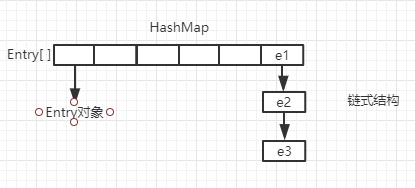
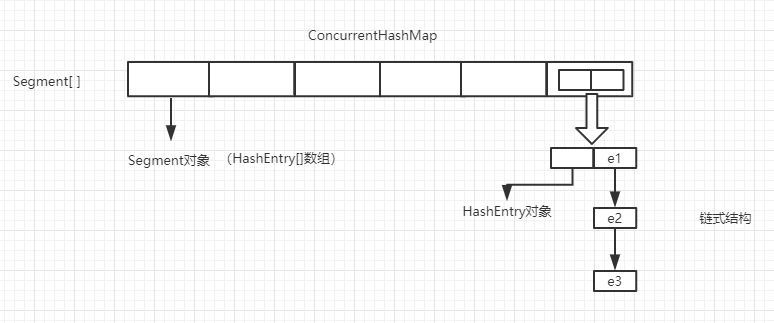
代码:

1 //默认初始容量(2的幂),实际上是指的HashEntry的数量 2 static final int DEFAULT_INITIAL_CAPACITY = 16; 3 //默认加载因子 4 static final float DEFAULT_LOAD_FACTOR = 0.75f; 5 //默认并发级别(实际上指的Segmengt对象的数量,初始化后不可更改) 6 static final int DEFAULT_CONCURRENCY_LEVEL = 16; 7 //最大容量小于等于2的30次幂 8 static final int MAXIMUM_CAPACITY = 1 << 30; 9 //最小SEGMENT容量(一个Segment里至少有两个HashEntry) 10 static final int MIN_SEGMENT_TABLE_CAPACITY = 2; 11 //最大SEGMENT容量容量 12 static final int MAX_SEGMENTS = 1 << 16; 13 //加锁之前的重试次数 14 static final int RETRIES_BEFORE_LOCK = 2; 15 //Segment数组 16 final Segment<K,V>[] segments; 17 //计算segment位置的掩码,用于计算Segment[]下标 18 final int segmentMask; 19 //用于算segment位置时,hash参与运算的位数 20 final int segmentShift; 21 //内部类HashEntry,相当于HashMap中Entry[]中的Entry对象 22 static final class HashEntry<K,V> { 23 final int hash; 24 final K key; 25 volatile V value; 26 volatile HashEntry<K,V> next; 27 28 HashEntry(int hash, K key, V value, HashEntry<K,V> next) { 29 this.hash = hash; 30 this.key = key; 31 this.value = value; 32 this.next = next; 33 } 34 35 final void setNext(HashEntry<K,V> n) { 36 UNSAFE.putOrderedObject(this, nextOffset, n); 37 } 38 39 static final sun.misc.Unsafe UNSAFE; 40 static final long nextOffset; 41 static { 42 try { 43 UNSAFE = sun.misc.Unsafe.getUnsafe(); 44 Class k = HashEntry.class; 45 nextOffset = UNSAFE.objectFieldOffset 46 (k.getDeclaredField("next")); 47 } catch (Exception e) { 48 throw new Error(e); 49 } 50 } 51 } 52 //hash函数 53 private int hash(Object k) { 54 int h = hashSeed; 55 56 if ((0 != h) && (k instanceof String)) { 57 return sun.misc.Hashing.stringHash32((String) k); 58 } 59 60 h ^= k.hashCode(); 61 62 h += (h << 15) ^ 0xffffcd7d; 63 h ^= (h >>> 10); 64 h += (h << 3); 65 h ^= (h >>> 6); 66 h += (h << 2) + (h << 14); 67 return h ^ (h >>> 16); 68 } 69 //ConcurrentHashMap的构造方法 70 public ConcurrentHashMap(int initialCapacity, float loadFactor, int concurrencyLevel) {//初始容量,加载因子,并发级别 71 if (!(loadFactor > 0) || initialCapacity < 0 || concurrencyLevel <= 0)//保证参数不能小于0 72 throw new IllegalArgumentException(); 73 if (concurrencyLevel > MAX_SEGMENTS)//保证并发级别不能大于最大Segment容量 74 concurrencyLevel = MAX_SEGMENTS; 75 76 int sshift = 0; 77 int ssize = 1; 78 while (ssize < concurrencyLevel) { 79 ++sshift;//统计ssize左移的次数 80 ssize <<= 1;//初始是1,通过左移然后2、4、8、16...作用是找到大于等于并发级别的2的“sshift”次幂 81 } 82 this.segmentShift = 32 - sshift;//用于Put方法中,求Segment[]数组的下标时用 83 this.segmentMask = ssize - 1;//Segmengt[].length-1 84 if (initialCapacity > MAXIMUM_CAPACITY)//如果初始容量大于最大 85 initialCapacity = MAXIMUM_CAPACITY;//则选择最大容量作为容量 86 int c = initialCapacity / ssize;//HashEntry[].length/Segmengt[].length,用来标记HashEntry的数量 87 if (c * ssize < initialCapacity)//例如initialCapacity = 9,concurrencyLevel(ssize) = 8 ,则initialCapacity / ssize = 1,c * ssize < initialCapacity 88 ++c; // 然后让C = 2, 此时 c * ssize >= initialCapacity ,这里的目的就是保证数据都被Segmengt存储。 89 int cap = MIN_SEGMENT_TABLE_CAPACITY; 90 while (cap < c)//拿最小的容量和刚刚计算的 c 进行比较 91 cap <<= 1; // 保证最小容量是2的n次幂 92 Segment<K,V> s0 = 93 new Segment<K,V>(loadFactor, (int)(cap * loadFactor), 94 (HashEntry<K,V>[])new HashEntry[cap]);//初始化Segment对象 95 Segment<K,V>[] ss = (Segment<K,V>[])new Segment[ssize];//初始化Segment数组 96 UNSAFE.putOrderedObject(ss, SBASE, s0); //调用Unsafe中的方法,作用是把刚刚初始化的Segemengt对象s0,放到刚刚初始化Segment[]数组中的Segment[0],也就是第一位 97 this.segments = ss; 98 } 99 //Put方法 100 public V put(K key, V value) { 101 Segment<K,V> s; 102 if (value == null) 103 throw new NullPointerException();//不能传null,此处个人认为应该加个 key也不能为 null的判断 104 int hash = hash(key);//计算hash值 105 int j = (hash >>> segmentShift) & segmentMask; // 计算Segmengt[]下标,即数据存储的位置 106 if ((s = (Segment<K,V>)UNSAFE.getObject(segments, (j << SSHIFT) + SBASE)) == null) // 调用Unsafe的方法,作用是获取Segmengt[j]的对象,如果等于空 107 s = ensureSegment(j);//判断第j个位置是不是为空,保证线程安全性 108 return s.put(key, hash, value, false);//调用Segmengt对象的put方法 109 } 110 111 //Segmengt的Put方法 112 final V put(K key, int hash, V value, boolean onlyIfAbsent) { 113 HashEntry<K,V> node = tryLock() ? null : scanAndLockForPut(key, hash, value);//加锁,保证线程安全 114 V oldValue; 115 try { 116 HashEntry<K,V>[] tab = table; 117 int index = (tab.length - 1) & hash; 118 HashEntry<K,V> first = entryAt(tab, index);//获取该位置的第一个元素,然后遍历链表 119 for (HashEntry<K,V> e = first;;) { 120 if (e != null) { 121 K k; 122 if ((k = e.key) == key || 123 (e.hash == hash && key.equals(k))) { 124 oldValue = e.value; 125 if (!onlyIfAbsent) { 126 e.value = value; 127 ++modCount; 128 } 129 break; 130 } 131 e = e.next; 132 } 133 else { 134 if (node != null) 135 node.setNext(first); 136 else 137 node = new HashEntry<K,V>(hash, key, value, first); 138 int c = count + 1; 139 if (c > threshold && tab.length < MAXIMUM_CAPACITY) 140 rehash(node); 141 else 142 setEntryAt(tab, index, node); 143 ++modCount; 144 count = c; 145 oldValue = null; 146 break; 147 } 148 } 149 } finally { 150 unlock(); 151 } 152 return oldValue; 153 } 154 155 @SuppressWarnings("unchecked") 156 private void rehash(HashEntry<K,V> node) {//扩容方法,只扩容HashEntry[],没扩容Segmengt[] 157 158 HashEntry<K,V>[] oldTable = table; 159 int oldCapacity = oldTable.length; 160 int newCapacity = oldCapacity << 1; 161 threshold = (int)(newCapacity * loadFactor); 162 HashEntry<K,V>[] newTable = 163 (HashEntry<K,V>[]) new HashEntry[newCapacity]; 164 int sizeMask = newCapacity - 1; 165 for (int i = 0; i < oldCapacity ; i++) { 166 HashEntry<K,V> e = oldTable[i]; 167 if (e != null) { 168 HashEntry<K,V> next = e.next; 169 int idx = e.hash & sizeMask; 170 if (next == null) 171 newTable[idx] = e; 172 else { 173 HashEntry<K,V> lastRun = e; 174 int lastIdx = idx; 175 for (HashEntry<K,V> last = next; 176 last != null; 177 last = last.next) { 178 int k = last.hash & sizeMask; 179 if (k != lastIdx) { 180 lastIdx = k; 181 lastRun = last; 182 } 183 } 184 newTable[lastIdx] = lastRun; 185 186 for (HashEntry<K,V> p = e; p != lastRun; p = p.next) { 187 V v = p.value; 188 int h = p.hash; 189 int k = h & sizeMask; 190 HashEntry<K,V> n = newTable[k]; 191 newTable[k] = new HashEntry<K,V>(h, p.key, v, n); 192 } 193 } 194 } 195 } 196 int nodeIndex = node.hash & sizeMask; 197 node.setNext(newTable[nodeIndex]); 198 newTable[nodeIndex] = node; 199 table = newTable; 200 } 201 202 private HashEntry<K,V> scanAndLockForPut(K key, int hash, V value) { 203 HashEntry<K,V> first = entryForHash(this, hash); 204 HashEntry<K,V> e = first; 205 HashEntry<K,V> node = null; 206 int retries = -1; 207 while (!tryLock()) { 208 HashEntry<K,V> f; 209 if (retries < 0) { 210 if (e == null) { 211 if (node == null) 212 node = new HashEntry<K,V>(hash, key, value, null); 213 retries = 0; 214 } 215 else if (key.equals(e.key)) 216 retries = 0; 217 else 218 e = e.next; 219 } 220 else if (++retries > MAX_SCAN_RETRIES) { 221 lock(); 222 break; 223 } 224 else if ((retries & 1) == 0 && 225 (f = entryForHash(this, hash)) != first) { 226 e = first = f; 227 retries = -1; 228 } 229 } 230 return node; 231 } 232 233 private void scanAndLock(Object key, int hash) { 234 235 HashEntry<K,V> first = entryForHash(this, hash); 236 HashEntry<K,V> e = first; 237 int retries = -1; 238 while (!tryLock()) { 239 HashEntry<K,V> f; 240 if (retries < 0) { 241 if (e == null || key.equals(e.key)) 242 retries = 0; 243 else 244 e = e.next; 245 } 246 else if (++retries > MAX_SCAN_RETRIES) { 247 lock(); 248 break; 249 } 250 else if ((retries & 1) == 0 && 251 (f = entryForHash(this, hash)) != first) { 252 e = first = f; 253 retries = -1; 254 } 255 } 256 } 257 258 final V remove(Object key, int hash, Object value) { 259 if (!tryLock()) 260 scanAndLock(key, hash); 261 V oldValue = null; 262 try { 263 HashEntry<K,V>[] tab = table; 264 int index = (tab.length - 1) & hash; 265 HashEntry<K,V> e = entryAt(tab, index); 266 HashEntry<K,V> pred = null; 267 while (e != null) { 268 K k; 269 HashEntry<K,V> next = e.next; 270 if ((k = e.key) == key || 271 (e.hash == hash && key.equals(k))) { 272 V v = e.value; 273 if (value == null || value == v || value.equals(v)) { 274 if (pred == null) 275 setEntryAt(tab, index, next); 276 else 277 pred.setNext(next); 278 ++modCount; 279 --count; 280 oldValue = v; 281 } 282 break; 283 } 284 pred = e; 285 e = next; 286 } 287 } finally { 288 unlock(); 289 } 290 return oldValue; 291 } 292 293 final boolean replace(K key, int hash, V oldValue, V newValue) { 294 if (!tryLock()) 295 scanAndLock(key, hash); 296 boolean replaced = false; 297 try { 298 HashEntry<K,V> e; 299 for (e = entryForHash(this, hash); e != null; e = e.next) { 300 K k; 301 if ((k = e.key) == key || 302 (e.hash == hash && key.equals(k))) { 303 if (oldValue.equals(e.value)) { 304 e.value = newValue; 305 ++modCount; 306 replaced = true; 307 } 308 break; 309 } 310 } 311 } finally { 312 unlock(); 313 } 314 return replaced; 315 } 316 317 final V replace(K key, int hash, V value) { 318 if (!tryLock()) 319 scanAndLock(key, hash); 320 V oldValue = null; 321 try { 322 HashEntry<K,V> e; 323 for (e = entryForHash(this, hash); e != null; e = e.next) { 324 K k; 325 if ((k = e.key) == key || 326 (e.hash == hash && key.equals(k))) { 327 oldValue = e.value; 328 e.value = value; 329 ++modCount; 330 break; 331 } 332 } 333 } finally { 334 unlock(); 335 } 336 return oldValue; 337 } 338 339 final void clear() { 340 lock(); 341 try { 342 HashEntry<K,V>[] tab = table; 343 for (int i = 0; i < tab.length ; i++) 344 setEntryAt(tab, i, null); 345 ++modCount; 346 count = 0; 347 } finally { 348 unlock(); 349 } 350 } 351 } 352 //Get方法 353 public V get(Object key) { 354 Segment<K,V> s; 355 HashEntry<K,V>[] tab; 356 int h = hash(key); 357 long u = (((h >>> segmentShift) & segmentMask) << SSHIFT) + SBASE;//先获取Segment[] 的下标 358 if ((s = (Segment<K,V>)UNSAFE.getObjectVolatile(segments, u)) != null && (tab = s.table) != null) { //用Unsafe的方法获取到Segment对象 359 //用Unsafe的方法HashEntry对象,然后遍历链表 360 for (HashEntry<K,V> e = (HashEntry<K,V>) UNSAFE.getObjectVolatile(tab, ((long)(((tab.length - 1) & h)) << TSHIFT) + TBASE); e != null; e = e.next) { 361 K k; 362 if ((k = e.key) == key || (e.hash == h && key.equals(k))) 363 return e.value; 364 } 365 } 366 return null; 367 }
JDK1.8:
JDK1.8时,ConcurrentHashMap又放弃了分段式加锁的思想,而且也不在用Segment[]数组存值,而是采用在HashMap1.8的基础上,采用Node[] + 链表 + 红黑树 + CAS+ Synchronized 的思想保证线程安全。而且在扩容的时候,不仅要满足链表结构大于8,还要满足数据容量大于64。
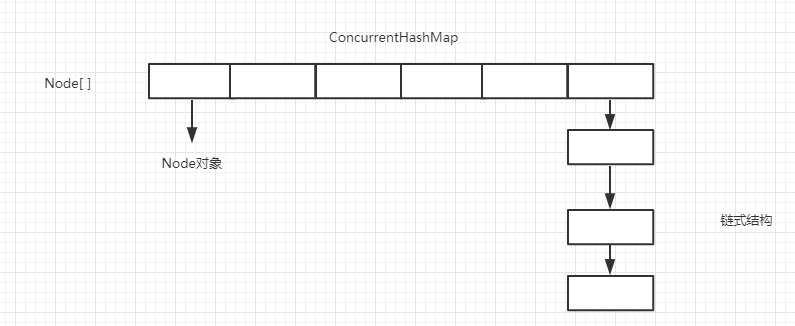

1 //最大容量 2 private static final int MAXIMUM_CAPACITY = 1 << 30; 3 //默认容量 4 private static final int DEFAULT_CAPACITY = 16; 5 //最大数组长度 6 static final int MAX_ARRAY_SIZE = Integer.MAX_VALUE - 8; 7 //默认并发等级(1.7遗留,兼容以前版本) 8 private static final int DEFAULT_CONCURRENCY_LEVEL = 16; 9 //加载因子(1.7遗留,兼容以前版本) 10 private static final float LOAD_FACTOR = 0.75f; 11 //转换为红黑树的阈值(道理和HashMap1.8中一样,这里指链表长度) 12 static final int TREEIFY_THRESHOLD = 8; 13 //红黑树反转成链表的阈值 14 static final int UNTREEIFY_THRESHOLD = 6; 15 //转换为红黑树的阈值(这里指数组长度) 16 static final int MIN_TREEIFY_CAPACITY = 64; 17 //扩容转移时的最小数组分组大小 18 private static final int MIN_TRANSFER_STRIDE = 16; 19 //本类中没提供修改的方法 用来根据n生成位置一个类似时间搓的功能 20 private static int RESIZE_STAMP_BITS = 16; 21 // 2^15-1,help resize的最大线程数 22 private static final int MAX_RESIZERS = (1 << (32 - RESIZE_STAMP_BITS)) - 1; 23 // 32-16=16,sizeCtl中记录size大小的偏移量 24 private static final int RESIZE_STAMP_SHIFT = 32 - RESIZE_STAMP_BITS; 25 //表示正在转移 26 static final int MOVED = -1; 27 // 表示已转换为红黑树 28 static final int TREEBIN = -2; 29 // 保留 30 static final int RESERVED = -3; 31 // 用在计算hash时进行安位与计算消除负hash 32 static final int HASH_BITS = 0x7fffffff; 33 // 可用处理器数量 34 static final int NCPU = Runtime.getRuntime().availableProcessors(); 35 //构造函数 36 public ConcurrentHashMap(int initialCapacity, float loadFactor, int concurrencyLevel) { 37 if (!(loadFactor > 0.0f) || initialCapacity < 0 || concurrencyLevel <= 0)//判断参数是否大于等于0 38 throw new IllegalArgumentException(); 39 if (initialCapacity < concurrencyLevel) 40 initialCapacity = concurrencyLevel; // 容量最小为16 41 long size = (long)(1.0 + (long)initialCapacity / loadFactor); 42 int cap = (size >= (long)MAXIMUM_CAPACITY) ? 43 MAXIMUM_CAPACITY : tableSizeFor((int)size);//获取数组容量并保证不大于最大容量 44 this.sizeCtl = cap; 45 } 46 //Put方法 47 public V put(K key, V value) { 48 return putVal(key, value, false); 49 } 50 51 final V putVal(K key, V value, boolean onlyIfAbsent) { 52 if (key == null || value == null) throw new NullPointerException();//不允许存null 53 int hash = spread(key.hashCode());//计算hash值 54 int binCount = 0; 55 for (Node<K,V>[] tab = table;;) { 56 Node<K,V> f; int n, i, fh; 57 if (tab == null || (n = tab.length) == 0) 58 tab = initTable();//懒加载,数组为空时初始化 59 else if ((f = tabAt(tab, i = (n - 1) & hash)) == null) {//类似Unsafe获取对象的方法获取对象 60 if (casTabAt(tab, i, null, 61 new Node<K,V>(hash, key, value, null)))//CAS,如果获取位置为空,则将数据存入 62 break; 63 } 64 else if ((fh = f.hash) == MOVED)//首地址处不null 并且Node的hash是-1 表示是ForwardingNode节点正在rehash扩容 65 tab = helpTransfer(tab, f);//帮助扩容的方法 66 else { 67 V oldVal = null; 68 synchronized (f) {//加锁 69 if (tabAt(tab, i) == f) { 70 if (fh >= 0) { 71 binCount = 1; 72 for (Node<K,V> e = f;; ++binCount) { 73 K ek; 74 if (e.hash == hash && 75 ((ek = e.key) == key || 76 (ek != null && key.equals(ek)))) {//遍历链表,如果key重复,值替换,老值返回出去 77 oldVal = e.val; 78 if (!onlyIfAbsent) 79 e.val = value; 80 break; 81 } 82 Node<K,V> pred = e; 83 if ((e = e.next) == null) { 84 pred.next = new Node<K,V>(hash, key, 85 value, null); 86 break; 87 } 88 } 89 } 90 else if (f instanceof TreeBin) {//如果为红黑树的对象,调用红黑树的put方法 91 Node<K,V> p; 92 binCount = 2; 93 if ((p = ((TreeBin<K,V>)f).putTreeVal(hash, key, 94 value)) != null) { 95 oldVal = p.val; 96 if (!onlyIfAbsent) 97 p.val = value; 98 } 99 } 100 } 101 } 102 if (binCount != 0) { 103 if (binCount >= TREEIFY_THRESHOLD) 104 //如果链表数据超过指定阈值,转换红黑树,并且会再进行一次判断,看数组容量是否大于64,数组大于64后才会转换为红黑树 105 treeifyBin(tab, i); 106 if (oldVal != null) 107 return oldVal; 108 break; 109 } 110 } 111 } 112 addCount(1L, binCount); 113 return null; 114 } 115 //Get方法,基本和1.8HashMap一样,获取数组坐标,然后获取Node对象,并且没有加锁。 116 public V get(Object key) { 117 Node<K,V>[] tab; Node<K,V> e, p; int n, eh; K ek; 118 int h = spread(key.hashCode()); 119 if ((tab = table) != null && (n = tab.length) > 0 && 120 (e = tabAt(tab, (n - 1) & h)) != null) { 121 if ((eh = e.hash) == h) { 122 if ((ek = e.key) == key || (ek != null && key.equals(ek))) 123 return e.val; 124 } 125 else if (eh < 0) 126 return (p = e.find(h, key)) != null ? p.val : null; 127 while ((e = e.next) != null) { 128 if (e.hash == h && 129 ((ek = e.key) == key || (ek != null && key.equals(ek)))) 130 return e.val; 131 } 132 } 133 return null; 134 }
注意:分析ConcurrentHashMap源码前,需要先了解一下CAS、Unsafe、Synchronized 、Volatile相关知识。
